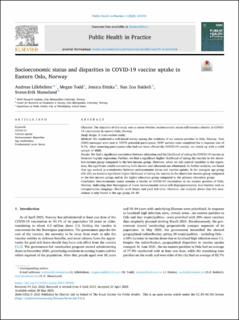| dc.contributor.author | Lillebråten, Andreas | |
| dc.contributor.author | Todd, Megan | |
| dc.contributor.author | Dimka, Jessica | |
| dc.contributor.author | Bakkeli, Nan Zou | |
| dc.contributor.author | Mamelund, Svenn-Erik | |
| dc.date.accessioned | 2023-10-19T06:19:52Z | |
| dc.date.available | 2023-10-19T06:19:52Z | |
| dc.date.created | 2023-05-28T19:24:41Z | |
| dc.date.issued | 2023 | |
| dc.identifier.issn | 2666-5352 | |
| dc.identifier.uri | https://hdl.handle.net/11250/3097394 | |
| dc.description.abstract | Objective: The objective of this study was to assess whether socioeconomic status still remain a barrier to COVID-
19 vaccination in eastern Oslo, Norway.
Study design: A cross-section study.
Methods: We conducted a web-based survey among the residents of six eastern parishes in Oslo, Norway. Text
(SMS) messages were sent to 59978 potential participants. 5447 surveys were completed for a response rate of
9.1%. After removing participants who had not been offered the COVID-19 vaccine, we ended up with a valid
sample of 4000.
Results: We find a significant association between education and the likelihood of taking the COVID-19 vaccine in
bivariate logistic regression. Further, we find a significant higher likelihood of taking the vaccine in the above-
low-income group compared to the low-income group. However, when we add control variables to the regres-
sion, the significant results concerning both income and education are eliminated. In further analysis, we found
that age worked as a moderator between socioeconomic status and vaccine uptake: In the youngest age group
(18–29), we found a significant higher likelihood of taking the vaccine in the above-low-income group compared
to the low-income group, and in the higher education group compared to the primary education group.
Conclusion: Socioeconomic status remains a barrier to COVID-19 vaccination in the eastern parishes of Oslo,
Norway. Indicating that Norwegians of lower socioeconomic status still disproportionately face barriers such as
transportation, language, flexible work hours, and paid sick time. However, our analysis shows that this asso-
ciation is only found in the age group 18–29. | en_US |
| dc.language.iso | eng | en_US |
| dc.relation.uri | https://doi.org/10.1016/j.puhip.2023.100391 | |
| dc.rights | Attribution-NonCommercial-NoDerivatives 4.0 Internasjonal | * |
| dc.rights.uri | http://creativecommons.org/licenses/by-nc-nd/4.0/deed.no | * |
| dc.title | Socioeconomic status and disparities in COVID-19 vaccine uptake in Eastern Oslo, Norway | en_US |
| dc.type | Peer reviewed | en_US |
| dc.type | Journal article | en_US |
| dc.description.version | publishedVersion | en_US |
| cristin.ispublished | true | |
| cristin.fulltext | original | |
| cristin.qualitycode | 1 | |
| dc.identifier.doi | 10.1016/j.puhip.2023.100391 | |
| dc.identifier.cristin | 2149865 | |
| dc.source.journal | Public Health in Practice | en_US |
| dc.source.volume | 5 | en_US |
| dc.relation.project | Norges forskningsråd: 302336 | en_US |

